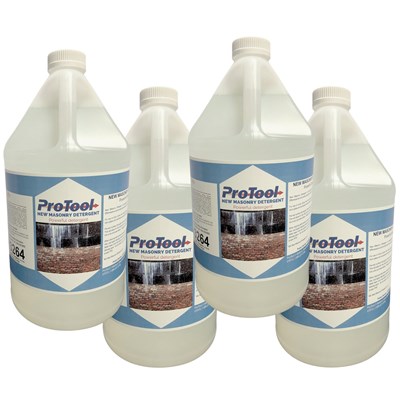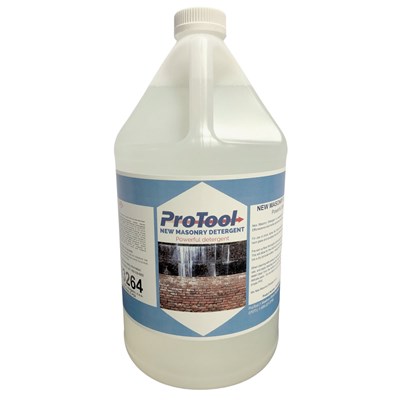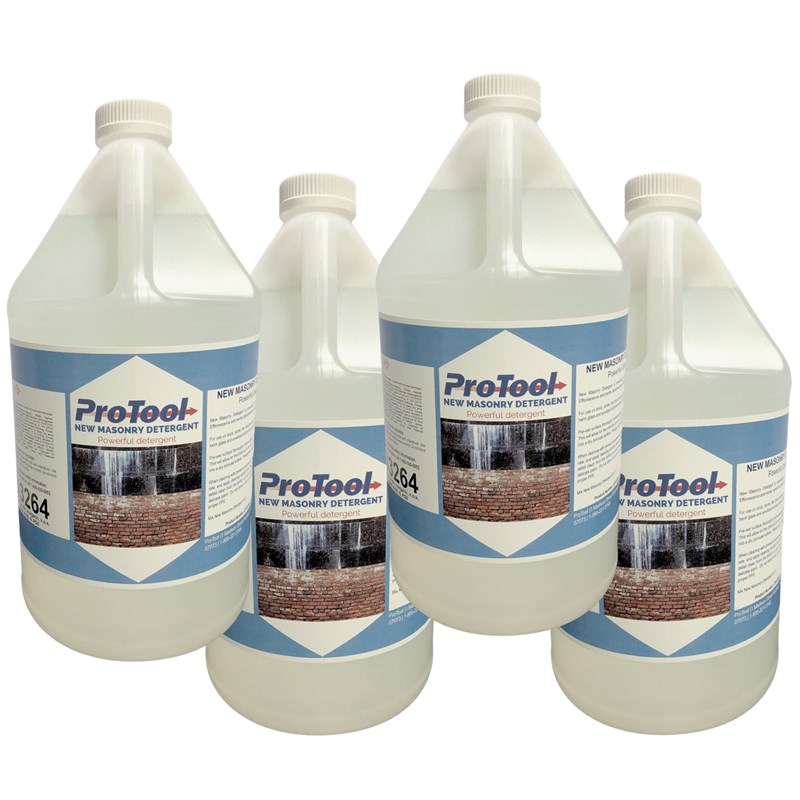ProTool Masonry Detergent 4 Gallon Case
Quick Overview
- Designed to remove a variety of stains and contaminants from surfaces such as such as brick, stone, concrete, and stucco
- A penetrating cleaner, Masonry Detergent effectively dissolves and lifts common stains found on masonry surfaces, including dirt, grime, algae, mold, mildew, efflorescence.
- Easy to apply using different methods, including down streamed by a pressure washer, tank based sprayer application, brush application, depending the surface being cleaned.
- Able to be used on all masonry surfaces including stone, brick, precast concrete, designer or colored block
- Use on vertical and horizontal surfaces, not for use on polished stone, limestone, metal surfaces or wood, avoid spraying on plants
Show More
ProTool Masonry Detergent 4 Gallon Case
New Masonry Cleaner 4 Gallon Case
Cleans masonry surfaces including stone, brick, cracked block, pavers, hardy board and precast concrete.
Before starting. Test a adjoining surfaces to understand protection needs, place a drop on the nearby surface (windows, dooors, frames, fixtures, allowing the drop to dwell for 15 minutes, if there is any discoloration these surfaces will need to be protected.Recommended equipment:
Spray on with a down stream injector from a pressure washer, X-jet, a premixed solution from a tank based sprayer or you can use ProTool Clever injector spraying system for precision mixing.

Mix Ratio is 4 parts water to 1 part Masonry Cleaner (20% mix rate)
Coverage is 100 to 200 sqft of solution depending ion the porosity of the surface
Instruction:
1) Moisten the surface, wet it down but don't flood the surface
2) Apply the diluted solution, spray top down on vertical surfaces
3) Reapplication is often required where mortar has been splattered about.
4) After a dwell period scraping the larger splatter will speed up the process
Note: Reapplication is performed with rinsing in between
Watch for foaming as the foaming diminishes the work is completed.
5) When satisfied with the cleaning rinse the surface with water.
Know your surface, sandstone, limestone and other softer surfaces should be rinsed at a very low pressures. Garden Hose or about 60 psi
For more robust surfaces use a large sized orifice fan tip to rinse and generate a pressure below 800psi with a high flow on to rinse the more robust Brick and stone surfaces with your wand.
- Easy to setup and use
- Precise and constant dosage at various flow rates
- SH capable and supports a wide range of liquid or soluble concentrates
- Proportional system eliminates risks of under or overdosing
- Externally adjustable and operates continuously
- Item: 150-0759


Safety Information
Use chemical resistant gloves
Avoid prolonged contact with skin, do not wear contacts
do not combine the cleaner with aboy other chemical, only dilute with clear water.
Hazmat Reference UN3264

Proposition 65 requires businesses to provide warnings to Californians about significant exposures to chemicals that cause cancer, birth defects or other reproductive harm. These chemicals can be in the products that Californians purchase, in their homes or workplaces, or that are released into the environment. By requiring that this information be provided, Proposition 65 enables Californians to make informed decisions about their exposures to these chemicals. Proposition 65 also prohibits California businesses from knowingly discharging significant amounts of listed chemicals into sources of drinking water. Proposition 65 requires California to publish a list of chemicals known to cause cancer, birth defects or other reproductive harm. This list, which must be updated at least once a year, has grown to include approximately 900 chemicals since it was first published in 1987. Proposition 65 became law in November 1986, when California voters approved it by a 63-37 percent margin. The official name of Proposition 65 is the Safe Drinking Water and Toxic Enforcement Act of 1986.
The list of chemicals contains a wide range of naturally occurring and synthetic chemicals that include additives or ingredients in pesticides, common household products, food, drugs, dyes, or solvents. Listed chemicals may also be used in manufacturing and construction, or they may be byproducts of chemical processes, such as motor vehicle exhaust. For more information visit www.p65warnings.ca.gov/








